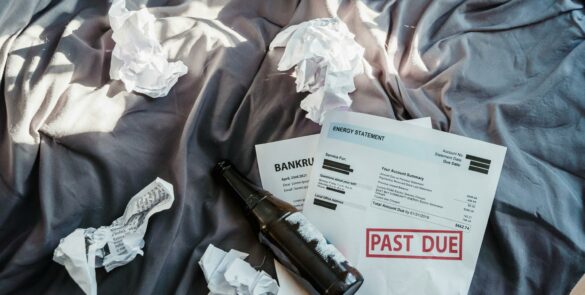Consumer Proposal in Canada: Is It The Right Solution?



Mounting debt is hard. We get it and know how stressful it feels. Our guide will show you the way out with a consumer proposal. It cuts down your debts and keeps creditors away. The Office of the Superintendent of Bankruptcy (OSB) watches over this process to ease your financial stress.
A consumer proposal means new hope, right?
As Of April 25, 2025, This Link Will Get You In Contact With the Director of Finance for Honest and Affordable Finacing.
Table of Contents
Key Takeaways
- A consumer proposal is a legal method in Canada to reduce debt if you owe less than $250,000, not counting your home mortgage. A Licensed Insolvency Trustee will handle talks with your creditors.
- It stops creditors and collection agencies from contacting you. Your property, like houses or cars, stays safe. Also, your debt stops gaining interest.
- This choice affects your credit report for three years after you finish payments. It’s usually better than bankruptcy because it protects your credit score more and lets you keep your assets.
- Creditors need to approve the trustee’s payment plan. This typically means paying back part of what you owe within five years or less.
- Choosing between a consumer proposal and other options like bankruptcy or debt consolidation depends on how much you owe, how much money you make, whether you want to keep certain assets, and how either option would affect your credit score.

What Is a Consumer Proposal
A consumer proposal is a legal way to reduce debt. You will get help from a Licensed Insolvency Trustee (LIT).They work out a new, smaller amount of debt you can actually pay.
The debts must be less than $250,000, not counting the main home’s mortgage. You must finish payments within five years.
Consumer Proposal vs Bankruptcy
Choosing between a consumer proposal and bankruptcy involves understanding the differences that affect your financial recovery. Here, we break down key points in a straightforward comparison.
Pros and Cons
| Consumer Proposal | Bankruptcy |
|---|---|
| Legal process for debts up to $250,000, not including mortgage on a primary residence. | Legal relief option for people with debts of any amount, with no upper limit. |
| Allows keeping assets like homes, cars, and retirement savings. | May require surrendering some assets to a trustee for debt repayment. |
| Debt is repaid over a period of up to 5 years. | Typically lasts 9 to 21 months for a first-time filing. |
| Credit report impact: stays for 7 years from the date of final payment. | Credit report impact: remains for 6 years after discharge for a first bankruptcy. |
| Requires repayment of part of the debt, based on income and assets. | May result in discharge of all eligible debts without repayment. |
| Managed by a Licensed Insolvency Trustee, but no monthly reporting to trustees. | Managed by a Licensed Insolvency Trustee with monthly income and expense reporting. |
| In 2023, surged by 24.3%, showing increased preference. | In the same period, declined by 8.97%, indicating a shift in favor. |
Both options offer paths to financial recovery, but they serve different needs based on your financial situation, ability to repay, and desire to retain assets. Understanding these differences helps in making an informed decision.
As Of April 25, 2025, This Link Will Get You In Contact With the Director of Finance for Honest and Affordable Finacing.
Consumer Proposal vs Debt Consolidation
Pros and Cons
| Feature | Consumer Proposal | Debt Consolidation |
|---|---|---|
| Legal Status | Formal, legally binding process | Informal, not legally binding |
| Debt Management | Payments made through a Licensed Insolvency Trustee | Payments made directly to the consolidation company |
| Credit Impact | Results in an R7 credit rating | May vary, but generally less severe than a consumer proposal |
| Protection from Creditors | Creditors must stop contacting you | Creditors may still contact if payments are not made |
| Preference | Preferred by government and creditors over bankruptcy | No particular preference from creditors |
| Debt Forgiveness | Remaining debt is forgiven after completion | Full amount of debt is still owed |
| Regulation | Federally regulated in Ontario | May not have the same federal regulation benefits |
| Requirements | Must meet specific criteria including debt limits and residency | Requirements may vary, generally more flexible |
Credit Counselling vs Consumer Proposal
Pros and Cons
| Feature | Credit Counselling | Consumer Proposal |
|---|---|---|
| Objective | Helps to manage debt through budgeting and a repayment plan with lower interest rates. | Legally binds you and creditors to a repayment plan that reduces the total debt amount. |
| Debt Reduction | May reduce interest rates but not the principal amount. | Can significantly reduce the total debt owed. |
| Legal Protection | Does not stop legal actions or collection calls. | Halt legal actions and stops collection calls. |
| Impact on Credit | Remains on credit report for 2-3 years after final payment. | Stays on credit report for up to 7 years after completion. |
| Provider | Non-profit organizations or private companies. | Only Licensed Insolvency Trustees can administer. |
| Costs | May include setup and monthly fees. | Costs are regulated and included in the debt repayment. |
| Eligibility | No specific debt limit. More flexible. | Debt must be less than $250,000 (excluding mortgage on principal residence). |
| Assets | Assets are not directly affected. | Allows you to keep your assets while repaying a portion of your debt. |
As Of April 25, 2025, This Link Will Get You In Contact With the Director of Finance for Honest and Affordable Finacing.
The Disadvantages of Consumer Proposal

- Lowers credit score to an R7 status, lasting three years after completion.
- Difficulty obtaining large loans, such as mortgages, with an R7 status.
- Potential ineligibility for certain jobs during the process.
- Does not clear secured debts like car loans. If you want to learn more about bad credit car loans, click here
- Filing is a public record, exposing financial issues to others.
- Certain licenses may be unattainable during the process.
So yes—a consumer proposal offers relief but also brings challenges that touch both credit health and personal life.
Is a Consumer Proposal Worth It?
If you are in a bad financial situation or have unpayable debt, a consumer proposal is most definitely worth it. Going through a consumer proposal helps cut down what you owe. It stops collection agencies from reaching out to you.
- Helps cut down the amount owed.
- Stops collection agencies from contacting you.
- Involves teaming up with Licensed Insolvency Trustees (LIT) to create a repayment plan.
- Allows repayment of less than the full amount over five years or less.
- Provides an alternative to bankruptcy for handling debt.
- Helps protect assets like houses or cars from being taken away.
- Stops lawsuits from unsecured creditors.
- Freezes interest on debts.
For many looking for relief from heavy debt without facing bankruptcy’s harsh effects, choosing a consumer proposal can be a wise move to getting back on track financially.
How Does a Consumer Proposal Work?
- Start by finding a Licensed Insolvency Trustee (LIT). They check your finances and see if a consumer proposal fits you.
- Your unsecured debt should be below $250,000, not counting the mortgage on your main home.
- With the trustee’s help, figure out an affordable payment plan that works for up to 5 years.
- The trustee makes a formal offer to pay back creditors less money or asks for more time, or both.
- This offer goes to all your unsecured creditors next.
- Creditors holding most of your debt must say yes for it to work.
- If they agree, stick with the payments. The trustee sends these payments to creditors without adding more interest.
- Go to at least two credit counselling sessions. These help you get smarter about handling money.
- Finish all payments as agreed, and any leftover unsecured debts disappear.
Your credit report will show this action for three years after completing it. This might change how lenders see you later on.
While doing this,
- No one can keep calling you about debts,
No more wage garnishments either thanks to stop orders.
How Long Does a Consumer Proposal Stay on Your Credit Report?
A consumer proposal affects your credit report for up to three years after you finish paying, or six years from when you filed it—whichever comes first.

As Of April 25, 2025, This Link Will Get You In Contact With the Director of Finance for Honest and Affordable Finacing.
How to Qualify For Consumer Proposal
1. Unsecured debts between $1,000 and $250,000 (excluding mortgage).
2. Includes credit card balances, personal loans, payday advances, and unpaid income taxes.
3. Must live in Canada or own property in Canada.
4. Must have a reliable income to repay some debts.
5. Must struggle with bills and debts.
6. Must have cash left after essential expenses for a payment plan.
7. List all income, expenses, and debts to assess suitability.
Choosing Between Consumer Proposal and Bankruptcy:
- Amount of debt.
- Income level.
- Secured vs. unsecured loans.
- Impact on secured credit cards or consolidation loans.
- Other financial considerations.
Professional Advice:
- Consult certified financial counseling experts.
- Manage insolvency issues efficiently.
- Ensure asset protection and effective repayment plans.
- Rebuild financial stability over time.
- Ensure compliance with legal requirements.

Frequently Asked Questions:
What is The Best Credit Card to Get After a Consumer Proposal
After finishing a consumer proposal, it’s smart to apply for a prepaid or secured credit card. You pay money upfront as security. This amount becomes your credit limit. It works like a debit card but helps rebuild your credit history.
How Bad is a Consumer Proposal
A consumer proposal will lower your credit score to an R7. This means you’ll find it hard to get new credit cards, personal loans, or lines of credit for three years after completing the proposal.
Is a Consumer Proposal The Same as Bankruptcy
Consumer proposals and bankruptcy help with debt but work differently. With a consumer proposal, you get to keep your stuff and pay back some of what you owe. Licensed Insolvency Trustees manage both options to make sure things go right.
Bankruptcy gets rid of unsecured debts fast, but you might lose some belongings. Unlike bankruptcy, a consumer proposal lets you hold onto your assets. Your choice between the two depends on how much debt you have and if you can handle new payment terms.
Both choices lead out of debt but fit different financial situations.
Can I Get a Loan While In a Consumer Proposal
Yes, you can get a loan in a consumer proposal. Lenders might see it as risky because you are already dealing with debt. They may offer financing, but at higher interest rates.
Can I keep a Credit Card During Consumer Proposal
Filing a consumer proposal means you have to give all your credit cards to the Licensed Insolvency Trustee. You can’t keep any cards, even if you don’t owe anything on them.
Conclusion
We talk a lot about consumer proposals in Canada. By working with a Licensed Insolvency Trustee, you stay on the right side of the law. This choice allows you to pay back less than what you owe and stops creditors from coming after you.
It’s not a simple decision, but it can really help if your debts are too much to handle. Think hard about the good and bad points before making up your mind.
As Of April 25, 2025, This Link Will Get You In Contact With the Director of Finance for Honest and Affordable Finacing.
